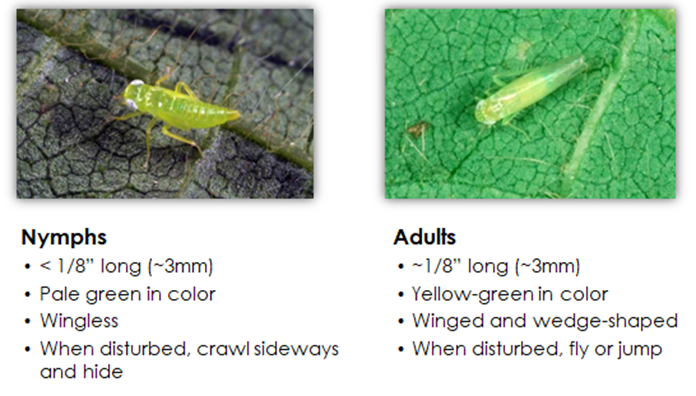Tips to Improve Herbicide Performance and Management of Potato Leafhoppers
BY Dairyland Seed Agronomy Team
HERBICIDE APPLICATION IN HOT AND DRY WEATHER
Hot and dry weather during postemergence spraying could result in less effective weed control and/or crop injury. Weeds exposed to hot and dry conditions develop a thicker waxy cuticle to slow water loss. This thicker waxy cuticle acts as a barrier and makes it difficult for herbicides to be absorbed into the plant. Herbicide that does enter the plant will not be able to move as quickly due to the slowed rate of translocation and metabolism.
Systemic herbicides need to be translocated through the plant to kill effectively and usually have the largest drop in efficacy under hot and dry conditions. Some examples of systemic herbicides are glyphosate, Assure II® and Select Max®, dicamba and 2,4-D. Contact herbicides, on the other hand, become more active at high temperatures. Although higher activity is good for weed control, it can also result in a higher risk for crop injury. Liberty®, Aim®, Cadet®, Cobra®, Reflex®/Flexstar®, Valor® and Sharpen® are also examples of contact herbicides, but are for use as Pre-Emerge products only.
Spraying during hot (above 85°F) and dry conditions also increases the risk for off-target movement, mainly in the form of volatilization and from temperature inversion. Volatilization is commonly associated with herbicides like dicamba and is more likely in high temperatures. During volatilization the herbicide turns to a vapor and is carried in the atmosphere, potentially long distances. Temperature inversions can trap the small herbicide droplets in the cool air layer and allow for off-target movement. Temperature inversions are more common two hours after sunrise and two hours before sunset with wind speeds less than 3 mph.
Tips to Improve Herbicide Performance
- Add recommended adjuvants at labeled rates for systemic herbicides
- When temps exceed 85°F avoid using MSO (Methylated Seed Oil) with certain systemic herbicides, specifically Clethodim containing herbicides such as Select Max®, Volunteer®, Clethodim 2E and others. MSO can cause excessive burn when used with these products in high temps.
- When using systemic herbicides, spray in the morning after plants have recovered from the heat but watch for temperature inversions
- Increase spray volume for better coverage
- Use lower herbicide rates instead of higher rates when applying contact herbicides
- For contact herbicides, consider spraying in the evening when temperatures are cooling down for the night
- Adding a quality deposition aid or drift control product aids in reducing drift potential but also can increase the amount of product on targeted weeds

Leaf circled in the picture shows necrotic spots from high surfactant use in 95°F temperatures. Some growing points of small plants were damaged in this application.
POTATO LEAFHOPPER MANAGEMENT
Potato Leafhoppers are destructive pests with piercing mouth parts that suck valuable nutrients directly out of the plant while depositing saliva which inhibits the normal function of plant cells. Both nymphs and adults can cause extensive damage called “hopper burn” due to the yellowing of leaf tips that reduces yield, forage quality, and plant vigor. The V-shaped yellowing on the leaflets and stunted plant growth will help distinguish potato leafhopper damage from Boron deficiency.

Newly seeded fields and those with less than three inches of re-growth after cutting are going to be the most susceptible and should be prioritized during scouting. Early detection is key to minimizing damage. Using a sweep net, gather 100 representative samples, broken down into groups of 10, throughout the field and count the number of insects collected. The total economic threshold of infestation will depend on the year of the stand as newer seeded fields are more valuable than older stands and will factor into the type and cost of control methods.


Source: Potato Leafhopper on Alfalfa; Ronald B. Hammond, Andy Michel, and James B. Eisley, Department of Entomology
Mark Sulc, Department of Horticulture and Crop Science; Ohio State University
You can see leafhoppers from early June through mid-August. Continuous monitoring throughout the growing season, especially if it’s hot and dry, will help control-methods be the most effective. Timely cutting the field is the best option for disrupting the lifecycle by killing the nymphs and forcing adults to scatter. Always check 7 to 10 days afterwards for reinfestation potential. Apply an approved foliar insecticide to fields not ready to be harvested to keep damage from turning catastrophic.
 |
 |
 |
 |
 |
| Brian Weller Western Region 507.456.3034 |
Dan Ritter Central Region 219.863.0583 |
Branden Furseth Northern Region 608.513.4265 |
Mark Gibson Eastern Region 260.330.8968 |
Amanda Goffnett Eastern Region 989.400.3793 |
